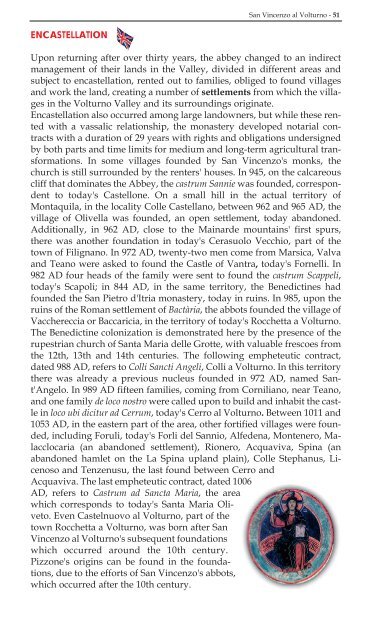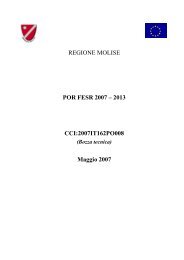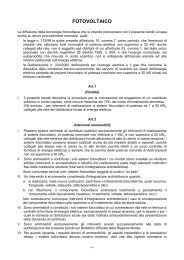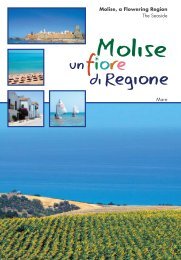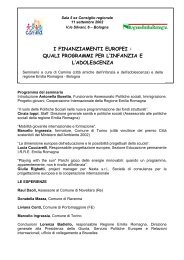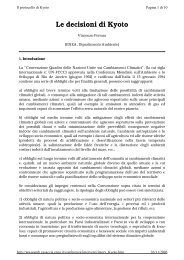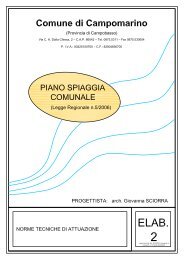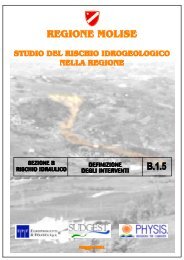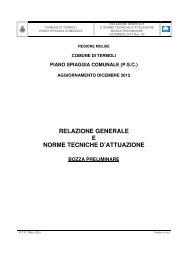Il Lago di Castel San Vincenzo e l'antica Terra ... - Regione Molise
Il Lago di Castel San Vincenzo e l'antica Terra ... - Regione Molise
Il Lago di Castel San Vincenzo e l'antica Terra ... - Regione Molise
Create successful ePaper yourself
Turn your PDF publications into a flip-book with our unique Google optimized e-Paper software.
ENCASTELLATION<br />
<strong>San</strong> <strong>Vincenzo</strong> al Volturno - 51<br />
Upon returning after over thirty years, the abbey changed to an in<strong>di</strong>rect<br />
management of their lands in the Valley, <strong>di</strong>vided in <strong>di</strong>fferent areas and<br />
subject to encastellation, rented out to families, obliged to found villages<br />
and work the land, creating a number of settlements from which the villages<br />
in the Volturno Valley and its surroun<strong>di</strong>ngs originate.<br />
Encastellation also occurred among large landowners, but while these rented<br />
with a vassalic relationship, the monastery developed notarial contracts<br />
with a duration of 29 years with rights and obligations undersigned<br />
by both parts and time limits for me<strong>di</strong>um and long-term agricultural transformations.<br />
In some villages founded by <strong>San</strong> <strong>Vincenzo</strong>'s monks, the<br />
church is still surrounded by the renters' houses. In 945, on the calcareous<br />
cliff that dominates the Abbey, the castrum <strong>San</strong>nie was founded, correspondent<br />
to today's <strong>Castel</strong>lone. On a small hill in the actual territory of<br />
Montaquila, in the locality Colle <strong>Castel</strong>lano, between 962 and 965 AD, the<br />
village of Olivella was founded, an open settlement, today abandoned.<br />
Ad<strong>di</strong>tionally, in 962 AD, close to the Mainarde mountains' first spurs,<br />
there was another foundation in today's Cerasuolo Vecchio, part of the<br />
town of Filignano. In 972 AD, twenty-two men come from Marsica, Valva<br />
and Teano were asked to found the Castle of Vantra, today's Fornelli. In<br />
982 AD four heads of the family were sent to found the castrum Scappeli,<br />
today's Scapoli; in 844 AD, in the same territory, the Bene<strong>di</strong>ctines had<br />
founded the <strong>San</strong> Pietro d'Itria monastery, today in ruins. In 985, upon the<br />
ruins of the Roman settlement of Bactària, the abbots founded the village of<br />
Vacchereccia or Baccaricia, in the territory of today's Rocchetta a Volturno.<br />
The Bene<strong>di</strong>ctine colonization is demonstrated here by the presence of the<br />
rupestrian church of <strong>San</strong>ta Maria delle Grotte, with valuable frescoes from<br />
the 12th, 13th and 14th centuries. The following empheteutic contract,<br />
dated 988 AD, refers to Colli <strong>San</strong>cti Angeli, Colli a Volturno. In this territory<br />
there was already a previous nucleus founded in 972 AD, named <strong>San</strong>t'Angelo.<br />
In 989 AD fifteen families, coming from Corniliano, near Teano,<br />
and one family de loco nostro were called upon to build and inhabit the castle<br />
in loco ubi <strong>di</strong>citur ad Cerrum, today's Cerro al Volturno. Between 1011 and<br />
1053 AD, in the eastern part of the area, other fortified villages were founded,<br />
inclu<strong>di</strong>ng Foruli, today's Forli del <strong>San</strong>nio, Alfedena, Montenero, Malacclocaria<br />
(an abandoned settlement), Rionero, Acquaviva, Spina (an<br />
abandoned hamlet on the La Spina upland plain), Colle Stephanus, Licenoso<br />
and Tenzenusu, the last found between Cerro and<br />
Acquaviva. The last empheteutic contract, dated 1006<br />
AD, refers to Castrum ad <strong>San</strong>cta Maria, the area<br />
which corresponds to today's <strong>San</strong>ta Maria Oliveto.<br />
Even <strong>Castel</strong>nuovo al Volturno, part of the<br />
town Rocchetta a Volturno, was born after <strong>San</strong><br />
<strong>Vincenzo</strong> al Volturno's subsequent foundations<br />
which occurred around the 10th century.<br />
Pizzone's origins can be found in the foundations,<br />
due to the efforts of <strong>San</strong> <strong>Vincenzo</strong>'s abbots,<br />
which occurred after the 10th century.


